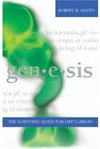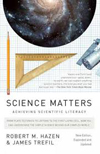Robert Hazen: Minerological Co-Evolution of the Geo- and Biosphere

 |
Talk by Robert Hazen
Host – US Geological Survey |
Books by Robert Hazen  |
Minerological Co-Evolution of the Geo- and Biosphere
The mineralogy of terrestrial planets and moons evolves as a consequence of selective physical, chemical and biological processes. Mineral evolution begins with approximately 12 different refractory minerals that form in the cooling envelopes of exploding stars. Subsequent aqueous and thermal alteration of planetessimals results in the approximately 250 minerals now found in unweathered lunar and meteorite samples.
 Following Earth’s accretion and differentiation, mineral evolution resulted from a sequence of geochemical and petrologic processes, which led to perhaps 1500 mineral species. According to some origin-of-life scenarios, a planet must progress through at least some of these stages of chemical processing as a prerequisite for life. Once life emerged, mineralogy and biology co-evolved and dramatically increased Earth’s mineral diversity to >4000 species. Sequential stages of mineral evolution arise from three primary mechanisms: (1) the progressive separation and concentration of the elements from their original relatively uniform distribution in the presolar nebula; (2) the increase in range of intensive variables such as pressure, temperature, and volatile activities; and (3) the generation of far-from-equilibrium conditions by living systems. Remote observations of the mineralogy of other terrestrial bodies may thus provide evidence for biological influences beyond Earth.
Following Earth’s accretion and differentiation, mineral evolution resulted from a sequence of geochemical and petrologic processes, which led to perhaps 1500 mineral species. According to some origin-of-life scenarios, a planet must progress through at least some of these stages of chemical processing as a prerequisite for life. Once life emerged, mineralogy and biology co-evolved and dramatically increased Earth’s mineral diversity to >4000 species. Sequential stages of mineral evolution arise from three primary mechanisms: (1) the progressive separation and concentration of the elements from their original relatively uniform distribution in the presolar nebula; (2) the increase in range of intensive variables such as pressure, temperature, and volatile activities; and (3) the generation of far-from-equilibrium conditions by living systems. Remote observations of the mineralogy of other terrestrial bodies may thus provide evidence for biological influences beyond Earth.
Image: Banded iron rock, mineral layers compressed in vibrant colours found in the Hammersley Range, Western Australia. Photo by Mint Images/ Frans Lanting/Getty from “Mineral Fodder” by Robert M. Hazen
Robert M. Hazen, Principal Investigator of the Deep Carbon Observatory. He is a research scientist at the Carnegie Institution of Washington’s Geophysical Laboratory and Clarence Robinson Professor of Earth Science at George Mason University, is Principal Investigator of the Deep Carbon Observatory, a 10-year international effort to advance knowledge of the chemical and biological roles of carbon in Earth’s interior. His book Genesis: The Scientific Quest for Life’s Origins describes the role of minerals in the origin of life, e.g. mineral-catalyzed organic synthesis and selective adsorption of organic molecules on mineral surfaces.
His new approach to mineralogy – mineral evolution – explores the co-evolution of the geo- and biospheres. Hazen served on the Committee on Public Understanding of Science of the American Association for the Advancement of Science, and on Advisory Boards for NOVA (WGBH Boston), Earth & Sky, Encyclopedia Americana, and the Carnegie Council. He appears frequently on radio and television programs on science, and developed two popular video courses: The Joy of Science and The Origins of Life, both produced by The Teaching Company.
He received his B.S. and S.M. in geology at Massachusetts Institute of Technology and Ph.D. at Harvard University in earth science, working as a NATO Postdoctoral Fellow at Cambridge University in England. Hazen is author of more than 350 articles and 20 books on science, history, and music. A Fellow of the American Association for the Advancement of Science, he received the Mineralogical Society of America Award (1982), American Chemical Society Ipatieff Prize (1986), ASCAP Deems Taylor Award (1989), Educational Press Association Award (1992), Elizabeth Wood Science Writing Award (1998), and the Distinguished Public Service Medal of the Mineralogical Society of America (2009). He has presented numerous named lectures at universities, and is currently Sigma Xi Distinguished Lecturer (2008-2010).
He served as Distinguished Lecturer for the Mineralogical Society of America, and is a Past President of the Society. Also a professional trumpeter, he’s performed with the Metropolitan, New York City, Boston, and Washington Operas, the Royal, Bolshoi, Joffrey, and Kirov Ballets, Boston Symphony, National Symphony, and Orchestre de Paris and is a member of the National Philharmonic, Washington Bach Consort, and National Gallery Orchestra.
